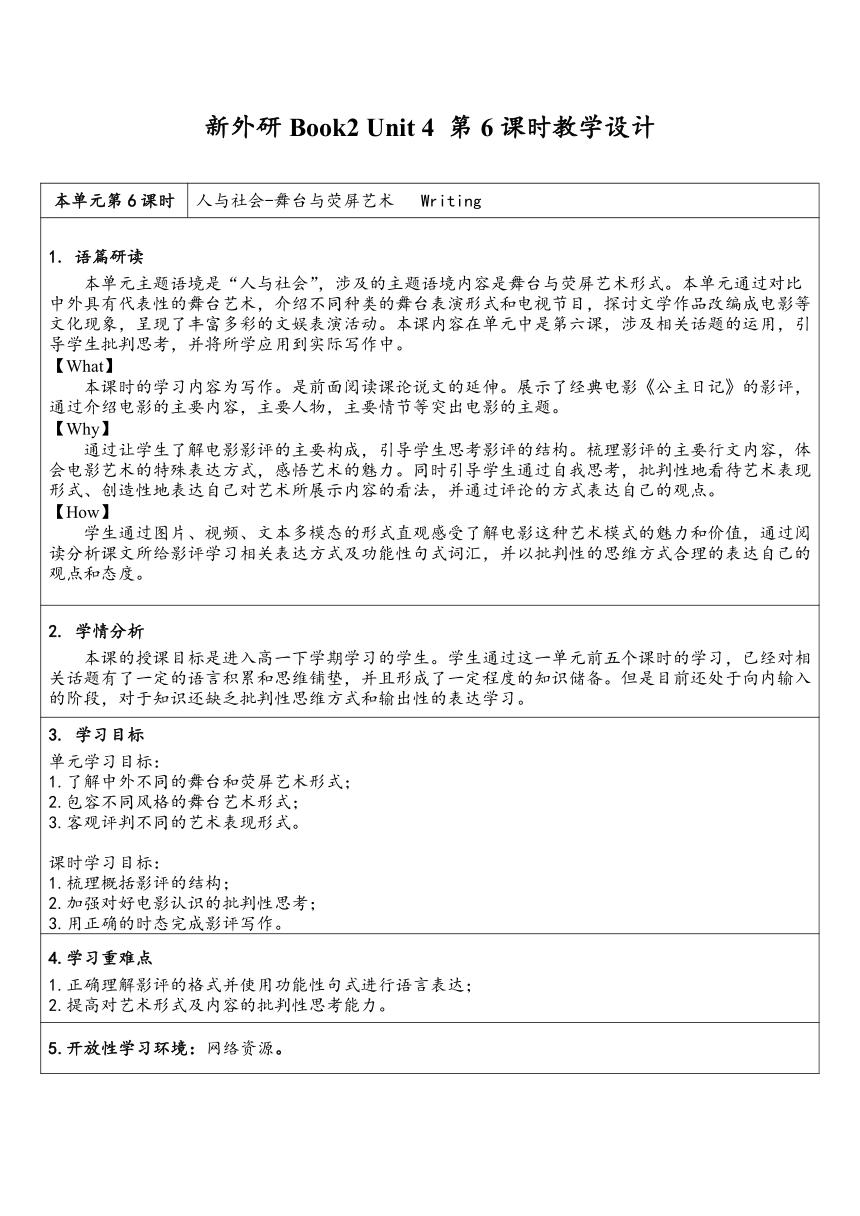外研版(2019)高中英语必修第二册 Unit 4 Stage and screen Developing ideas-writing 名师教学设计
文档属性
| 名称 | 外研版(2019)高中英语必修第二册 Unit 4 Stage and screen Developing ideas-writing 名师教学设计 |  | |
| 格式 | docx | ||
| 文件大小 | 35.2KB | ||
| 资源类型 | 教案 | ||
| 版本资源 | 外研版(2019) | ||
| 科目 | 英语 | ||
| 更新时间 | 2023-02-27 15:09:54 | ||
图片预览

文档简介
新外研Book2 Unit 4 第6课时教学设计
本单元第6课时 人与社会-舞台与荧屏艺术 Writing
语篇研读 本单元主题语境是“人与社会”,涉及的主题语境内容是舞台与荧屏艺术形式。本单元通过对比中外具有代表性的舞台艺术,介绍不同种类的舞台表演形式和电视节目,探讨文学作品改编成电影等文化现象,呈现了丰富多彩的文娱表演活动。本课内容在单元中是第六课,涉及相关话题的运用,引导学生批判思考,并将所学应用到实际写作中。 【What】 本课时的学习内容为写作。是前面阅读课论说文的延伸。展示了经典电影《公主日记》的影评,通过介绍电影的主要内容,主要人物,主要情节等突出电影的主题。 【Why】 通过让学生了解电影影评的主要构成,引导学生思考影评的结构。梳理影评的主要行文内容,体会电影艺术的特殊表达方式,感悟艺术的魅力。同时引导学生通过自我思考,批判性地看待艺术表现形式、创造性地表达自己对艺术所展示内容的看法,并通过评论的方式表达自己的观点。 【How】 学生通过图片、视频、文本多模态的形式直观感受了解电影这种艺术模式的魅力和价值,通过阅读分析课文所给影评学习相关表达方式及功能性句式词汇,并以批判性的思维方式合理的表达自己的观点和态度。
2. 学情分析 本课的授课目标是进入高一下学期学习的学生。学生通过这一单元前五个课时的学习,已经对相关话题有了一定的语言积累和思维铺垫,并且形成了一定程度的知识储备。但是目前还处于向内输入的阶段,对于知识还缺乏批判性思维方式和输出性的表达学习。
3. 学习目标 单元学习目标: 1.了解中外不同的舞台和荧屏艺术形式; 2.包容不同风格的舞台艺术形式; 3.客观评判不同的艺术表现形式。 课时学习目标: 1.梳理概括影评的结构; 2.加强对好电影认识的批判性思考; 3.用正确的时态完成影评写作。
4.学习重难点 1.正确理解影评的格式并使用功能性句式进行语言表达; 2.提高对艺术形式及内容的批判性思考能力。
5.开放性学习环境:网络资源。
6.课时教学过程(第1课时)
学习目标 学习活动 设计意图 效果评价 深度学习特征
引导学生进入情境,激发学生自主思考能力。 【感知与注意】 Activity 1: 1. T plays the video clip of the movie The Princess Diaries and asks if they have seen it before. 2. T ask Ss about how to recommend the movie to others and what should be included. To train Ss to acquire knowledge through viewing and build connections towards what they have learned before. 学生通过浏览电影片段引发观赏兴趣,同时进入情境,解决实际生活问题。 【联想与结构】 学生通过看视频,与已有知识进行联想。
学生认识并熟悉影评这种文体形式。【获取与梳理】 Activity 2. T asks Ss to read the passage and think about how many parts can this passage be divided into. To encourage Ss to think about the development of the passage individually. 学生能够阅读文本并梳理文章的主要内容。 【联想与结构】 学生自主思考文章的构成及布局方式。
引导学生概括段落主旨,梳理文章发展脉络,整合影评主要结构。 【概括与整合】 Activity 3. Ss are encouraged to conclude the key elements of a movie review after summarizing the main ideas of each paragraph. T asks Ss to summarize the structure of a movie review. To train Ss to summarize the main idea of each part and conclude the structure of a review. 学生能够概括影评重要组成部分并进行提炼整合。 【联想与结构】 学生将课文影评的结构内化并形成自我思考。
帮助学生理解三个部分在语篇中的作用,并举例介绍其语言形式。 【描述与阐释】 Activity 4. T introduce the function of each part (beginning, body, ending) and make illustrations separately by asking “What is it ” and “How to make it” questions as well as giving examples. To illustrate the meaning of each part and demonstrate them separately by giving examples. 学生能够体会三个部分在语篇中的功用并通过具体例子加深理解。 【内化与交流】 学生通过获取相关知识,理解不同部分实际写作的主要构成及需要运用的相关语言结构。
帮助学生处理影评的写作细节 【内化与运用】 Activity 5. T asks Ss to think about what tense we should use. T reappear the movie review and circle the verbs. 2. T asks Ss to think about how to make the review more coherent. T reappear the movie review and circle the linking words. To deepen the Ss comprehension of details of review writing especially the correct tense and the usage of linking words. 学生能通过回顾影评巩固这种写作方式中的主要细节,并通过正确时态和连词的运用加强文章连贯性和整体性。 【内化与交流】 学生通过分析文章细节,举一反三总结出影评的时态和行文特点。
鼓励学生独立思考【推理与论证】 Activity 6. T asks Ss to think about whether this movie is good or not. 2. What is the criteria of a good movie To improve their critical thinking and improving comprehension of movie review. 学生能够通过深度思考,唤醒自我思辨意识 【本质与变式】 学生运用所学词汇把所学成果外显
引导学生提高批判性思维能力 【批判与评价】 Activity 7. 1. T asks Ss what can they see from the selected reviews. 2. Why do the viewers use this kind of words to evaluate this movie? To learn to read the reviews in a deeper way and to evaluate movie from different aspects objectively 学生学会客观得看待电影这种艺术形式,思考电影作为艺术与商业共同产物的价值和功能。 【价值与评判】 学会客观地批判地看待自己
综合运用自己所习得的知识 【想象与创造】 Assignment:Choose a Chinese movie you like and write a movie review. To promote the integrated competence of using English language 学生能运用所学,运用功能性语言完成语言表达。 【迁移与创造】 学生运用所学与自身实际相关联
本单元第6课时 人与社会-舞台与荧屏艺术 Writing
语篇研读 本单元主题语境是“人与社会”,涉及的主题语境内容是舞台与荧屏艺术形式。本单元通过对比中外具有代表性的舞台艺术,介绍不同种类的舞台表演形式和电视节目,探讨文学作品改编成电影等文化现象,呈现了丰富多彩的文娱表演活动。本课内容在单元中是第六课,涉及相关话题的运用,引导学生批判思考,并将所学应用到实际写作中。 【What】 本课时的学习内容为写作。是前面阅读课论说文的延伸。展示了经典电影《公主日记》的影评,通过介绍电影的主要内容,主要人物,主要情节等突出电影的主题。 【Why】 通过让学生了解电影影评的主要构成,引导学生思考影评的结构。梳理影评的主要行文内容,体会电影艺术的特殊表达方式,感悟艺术的魅力。同时引导学生通过自我思考,批判性地看待艺术表现形式、创造性地表达自己对艺术所展示内容的看法,并通过评论的方式表达自己的观点。 【How】 学生通过图片、视频、文本多模态的形式直观感受了解电影这种艺术模式的魅力和价值,通过阅读分析课文所给影评学习相关表达方式及功能性句式词汇,并以批判性的思维方式合理的表达自己的观点和态度。
2. 学情分析 本课的授课目标是进入高一下学期学习的学生。学生通过这一单元前五个课时的学习,已经对相关话题有了一定的语言积累和思维铺垫,并且形成了一定程度的知识储备。但是目前还处于向内输入的阶段,对于知识还缺乏批判性思维方式和输出性的表达学习。
3. 学习目标 单元学习目标: 1.了解中外不同的舞台和荧屏艺术形式; 2.包容不同风格的舞台艺术形式; 3.客观评判不同的艺术表现形式。 课时学习目标: 1.梳理概括影评的结构; 2.加强对好电影认识的批判性思考; 3.用正确的时态完成影评写作。
4.学习重难点 1.正确理解影评的格式并使用功能性句式进行语言表达; 2.提高对艺术形式及内容的批判性思考能力。
5.开放性学习环境:网络资源。
6.课时教学过程(第1课时)
学习目标 学习活动 设计意图 效果评价 深度学习特征
引导学生进入情境,激发学生自主思考能力。 【感知与注意】 Activity 1: 1. T plays the video clip of the movie The Princess Diaries and asks if they have seen it before. 2. T ask Ss about how to recommend the movie to others and what should be included. To train Ss to acquire knowledge through viewing and build connections towards what they have learned before. 学生通过浏览电影片段引发观赏兴趣,同时进入情境,解决实际生活问题。 【联想与结构】 学生通过看视频,与已有知识进行联想。
学生认识并熟悉影评这种文体形式。【获取与梳理】 Activity 2. T asks Ss to read the passage and think about how many parts can this passage be divided into. To encourage Ss to think about the development of the passage individually. 学生能够阅读文本并梳理文章的主要内容。 【联想与结构】 学生自主思考文章的构成及布局方式。
引导学生概括段落主旨,梳理文章发展脉络,整合影评主要结构。 【概括与整合】 Activity 3. Ss are encouraged to conclude the key elements of a movie review after summarizing the main ideas of each paragraph. T asks Ss to summarize the structure of a movie review. To train Ss to summarize the main idea of each part and conclude the structure of a review. 学生能够概括影评重要组成部分并进行提炼整合。 【联想与结构】 学生将课文影评的结构内化并形成自我思考。
帮助学生理解三个部分在语篇中的作用,并举例介绍其语言形式。 【描述与阐释】 Activity 4. T introduce the function of each part (beginning, body, ending) and make illustrations separately by asking “What is it ” and “How to make it” questions as well as giving examples. To illustrate the meaning of each part and demonstrate them separately by giving examples. 学生能够体会三个部分在语篇中的功用并通过具体例子加深理解。 【内化与交流】 学生通过获取相关知识,理解不同部分实际写作的主要构成及需要运用的相关语言结构。
帮助学生处理影评的写作细节 【内化与运用】 Activity 5. T asks Ss to think about what tense we should use. T reappear the movie review and circle the verbs. 2. T asks Ss to think about how to make the review more coherent. T reappear the movie review and circle the linking words. To deepen the Ss comprehension of details of review writing especially the correct tense and the usage of linking words. 学生能通过回顾影评巩固这种写作方式中的主要细节,并通过正确时态和连词的运用加强文章连贯性和整体性。 【内化与交流】 学生通过分析文章细节,举一反三总结出影评的时态和行文特点。
鼓励学生独立思考【推理与论证】 Activity 6. T asks Ss to think about whether this movie is good or not. 2. What is the criteria of a good movie To improve their critical thinking and improving comprehension of movie review. 学生能够通过深度思考,唤醒自我思辨意识 【本质与变式】 学生运用所学词汇把所学成果外显
引导学生提高批判性思维能力 【批判与评价】 Activity 7. 1. T asks Ss what can they see from the selected reviews. 2. Why do the viewers use this kind of words to evaluate this movie? To learn to read the reviews in a deeper way and to evaluate movie from different aspects objectively 学生学会客观得看待电影这种艺术形式,思考电影作为艺术与商业共同产物的价值和功能。 【价值与评判】 学会客观地批判地看待自己
综合运用自己所习得的知识 【想象与创造】 Assignment:Choose a Chinese movie you like and write a movie review. To promote the integrated competence of using English language 学生能运用所学,运用功能性语言完成语言表达。 【迁移与创造】 学生运用所学与自身实际相关联
